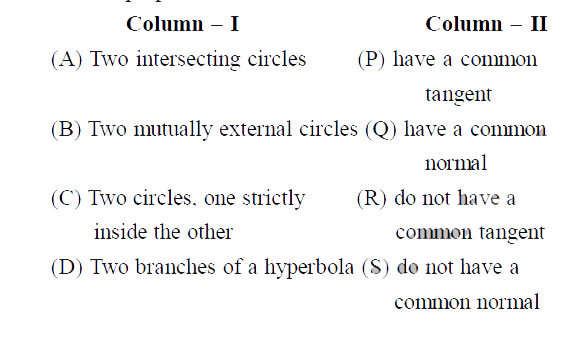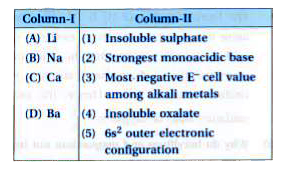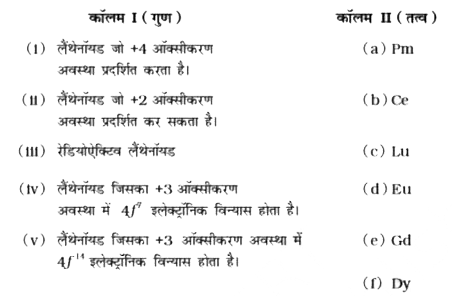Match the element in Column-I with the periodic property in Column-II
 Solution in Telugu
Solution in Telugu
The correct Answer is:A, B, C, D
Step by step video & image solution for Match the element in Column-I with the periodic property in Column-II by Chemistry experts to help you in doubts & scoring excellent marks in Class 11 exams.
Updated on:21/07/2023Topper's Solved these Questions
- PERIODIC PROPERTIESBOOK - AAKASH SERIESCHAPTER - PERIODIC PROPERTIESEXERCISE - LEVEL-II (TYPE-I) (PRACTICE SHEET-2(MORE THAN ONE CORRECT ANSWER))
5 Videos
- PERIODIC PROPERTIESBOOK - AAKASH SERIESCHAPTER - PERIODIC PROPERTIESEXERCISE - LEVEL-II (TYPE-I) (PRACTICE SHEET-2( COMPREHENSION))
5 Videos
- PERIODIC PROPERTIESBOOK - AAKASH SERIESCHAPTER - PERIODIC PROPERTIESEXERCISE - LEVEL-II (TYPE-I) (LECTURE SHEET-2 (COMPREHENSION ))
5 Videos
- PERIODIC CLASSIFICATIONBOOK - AAKASH SERIESCHAPTER - PERIODIC CLASSIFICATIONEXERCISE - OBJECTIVE EXERCISE - 3 (RECENT AIPMT/NEET QUESTIONS)
14 Videos
- PERIODIC TABLEBOOK - AAKASH SERIESCHAPTER - PERIODIC TABLEEXERCISE - EXERCISE ON PASSAGE
12 Videos
Similar Questions
Amongst the following statements, which is(are) correct ?
View SolutionThe amount of energy released when an electron is added to an isolated gaseous atom to produce a monovalent anion is called electron affinity or first electron affinity or electron gain enthalpy. The first electron is given a negative sign as the addition of an electron to a neutral atom is an exoergic process. The addition of electron to A−1 requires energy to overcome the force of repulsion. Thus, the second electron affinity is an endoergic process. The magnitude of electron affinity depends on a number of factors such as (i) atomic size (ii) effective nuclear charge (iii) screening effect (iv) half and fully filled orbitals and (v) shape of orbital. In general, electron affinity increases as the atomic radii decrease in a period. However, there are exceptions when the atoms have stable configurations. In a group, electron affinity decreases as the size increases. However, the members of 3rd period have somewhat higher values than the members in the 2nd period of the same subgroups.
Which one of the following arrangements represents the correct order of electron gain enthalpy (with negative sign) of the given atomic species ?
View SolutionThe minimum amount of energy required to remove the most loosely bound electron from an isolated atom in the gaseous state in known as ionisation energy or ionisation enthalpy (IE1) of the element. The energy required to remove the second electron from the monovalent cation is called second ionisation enthalpy (IE2). Similarly, we have third, fourth ..... inonisation enthalpies. The values of ionisation energy depends on a number of factors such as (i) size of the atom (ii) screening effect (iii) nuclear charge (iv) half filled and fully filled orbitals (v) shape of orbital. In a group, the ionisation energy decreases from top to bottom. In a period, the value of ionisation energy increases from left to right.
Compared to the second ionisation energy of an atom, the third ionisation
View SolutionWhich one of the following orders is not in accordance with the property stated against it?
View SolutionPASSAGE - 1: In Mendeleeff's periodic table elements were classified on the basis of atomic weight & in modern periodic table on the atomic number. The lighter elements of 2 & 3 periods show similarities in their properties called diagonal relationship
1. Which of the following element is not present in Mendeleeff's periodic table
View SolutionMatch the property given in Column I with the element given in Column II.

View SolutionMatch the property given in Column I with the element given in Column II.
View SolutionMatch the statements in Column I with the properties in Column II. A

View SolutionMatch the elements given in column I with the properties mentioned in Column II.
View SolutionMatch the element in Column I with the properties mentioned in Column II

View SolutionMatch the properties given in column I with the element given in column II
View SolutionMatch the property (column I) with the element (column II)

View SolutionMatch the property given in Column I with the element given in Column II.

View SolutionMatch the elements given in Column-I with the properties mentioned in Column-II :

View Solutionकॉलम I में दिय गुणों और कॉलम II में दिय तत्वों को सुमेलित कीजिए।

View Solution
